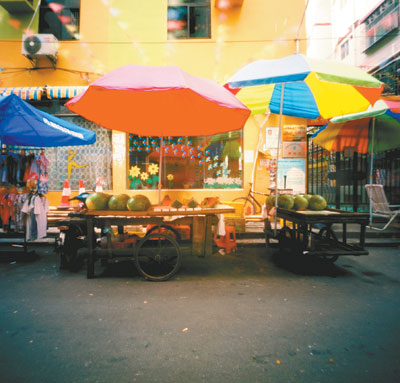|

Anne Zhang
zhangy49@gmail.com
FORGET about perfect lenses, accurate viewfinders and electronic shutters. Photography enthusiasts will have a chance to discover the beauty, simplicity and magic of pinhole cameras on Sunday, the Worldwide Pinhole Photography Day.
A pinhole camera, simply stated, is a box with a tiny hole at one end and photographic paper at the other. Pinhole photography is lensless photography. A very small hole replaces the camera lens. As light passes through the tiny hole, an image is formed inside the camera.
Every last Sunday of April is designated as the Worldwide Pinhole Photography Day to promote and celebrate this unique photographic art. A total of 291 pinhole photographers from 24 countries participated in the first Worldwide Pinhole Photography Day in 2001 and the number of participants rose to 3,865 last year, according to the event organizing committee.
The pinhole camera is the world’s first camera, invented in the 1850s. Before it was used as a camera with film, it was a tool to help artists learn to paint with more detail and a device used by scientists to observe a solar eclipse.
Sheila Bocchine, from the United States, is a professional pinhole photographer who also works as an English teacher at a kindergarten in Futian District. She has been engaged in pinhole photography for more than 12 years and has held her own pinhole photography exhibitions around the world including in Paris and Barcelona.
Bocchine said pinhole cameras can be made from a wide variety of things, including sea shells, oatmeal boxes, coke cans or cookie containers. A pinhole camera can be either small or large, and people have even used station wagons as a pinhole camera, as well as rooms in large buildings.
Bocchine said she loves pinhole photography because it is more artistic than traditional photography and she enjoys its interpretation of life — she feels like each pinhole photograph is a marvelous dream or a surreal and whimsical moment
During last year’s Worldwide Pinhole Photography Day, Bocchine wandered around Baishizhou, in Shenzhen’s Nanshan District, with her pinhole camera made from teak wood and took pinhole pictures of the markets, roads and old buildings in the area.
Several exhibitions, lectures and workshops concerning pinhole photography will be held around the world during this year’s Worldwide Pinhole Photography Day, including one workshop in Hong Kong. Participants will learn to make their own pinhole cameras, share their experiences and get inspiration to create new artworks.Fotologue-Pinhole Photography Workshop
Venue: Wai Kiu College, Hong Kong
Time: Feb. 21-May 23, 2013
Contact: Studio de Dimension de Tofu, Unit L6-22, Jockey Club Creative Arts Center, 30 Pak Tin Street, Shek Kip Mei, KLN, Hong Kong
Website: http://jccac.org.hk/?a=group&id=d&page=3&doc_id=584
Email: studio.de.tofu@hotmail.com
|

